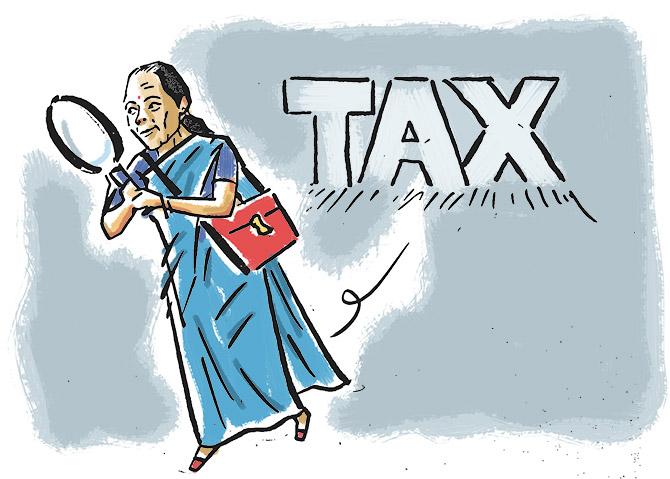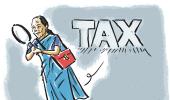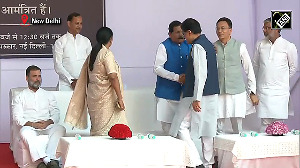Remember that by opting for one of the tax regimes, individual taxpayers don't get locked into it forever.
They retain the option to switch between the two every year, point out Sanjay Kumar Singh and Bindisha Sarang.
Illustration: Dominic Xavier /Rediff.com

Anisha Diwakar, 32, works as an executive assistant at a private company in Mumbai.
While she does save and invest, she does not like having her options limited to specified instruments for the purpose of tax saving.
She finds the new tax regime attractive.
"From the looks of it, the new format appears to be a better choice, as it will reduce paperwork," says Diwakar.
She plans to stick to the old regime for now but is eager to learn which one -- the old one with higher rates, or the new one with lower rates but without deductions -- will mean a lower tax burden for her.
A simpler regime
The new tax regime provides concessional tax rates compared to those prevailing in the old regime.
"A new tax slab of 10 per cent has been introduced for income between Rs 5 lakh and Rs 7.5 lakh, and tax rates have also been lowered," says Sameer Jain, founder and managing partner, PSL Advocates & Solicitors.
The new tax regime will put greater liquidity in the hands of taxpayers.
To avail of deductions under the old regime, taxpayers had to submit proof of investment and expenses (in the case of reimbursements).
They will be saved from all that trouble under the new regime.
"The documentation required will be lesser here, making tax filing a lot easier," says Suresh Surana, founder, RSM Astute Consulting Group.
The old regime forces taxpayers to invest in specific instruments on which deductions are available.
Not all of them are optimal choices for wealth creation.
Many less-informed taxpayers are mis-sold products that allow them to avail of tax deduction, but give very poor returns even over long durations.
All tax-saving investments come with a lock-in.
The Public Provident Fund (PPF) has a lock-in of 15 years, the five-year tax saving fixed deposit and National Savings Certificate (NSC) have a lock-in of five years, Equity Linked Savings Schemes (ELSS) have a lock in of three years, and so on.
Taxpayers moving to the new regime will be able to avoid the loss of liquidity that happens in such instruments.
On the flip side, taxpayers who choose the new regime, will have to manage without the long list of deductions available under the old regime.
These include taxpayers' favourites such as Section 80C (Rs 1.5 lakh), Section 80CCD(1B) that offers deduction of Rs 50,000 on National Pension System (NPS), Section 24 that offers deduction of Rs 2 lakh on housing loan interest repayment, and several others.
Only a few deductions will be permitted under the new regime, such as employer contribution to NPS.
Moreover, benefit from shifting to the new tax regime is capped at Rs 75,000.
"Unlike the corporate concessional tax regime, which reduces tax rates across income levels, the concessional tax regime for individuals has limited application and will benefit people in lower income brackets.
"The highest tax rate, which is 42.7 per cent, will continue to be a challenge for HNIs," says Surana.
Maximise benefits under old regime
Under the old regime, an employee's salary can be structured in a manner that allows him to maximise tax benefits, using deductions such as House Rent Allowance (HRA), Leave Travel Allowance (LTA), and so on.
The old tax regime also helps inculcate the saving and investment habit.
"Taxpayers are able to combine tax saving with creating a corpus for long-term goals by investing in products like the PPF," says Archit Gupta, founder and chief executive officer, ClearTax.
On the flip side, the old tax regime is more complex and requires a certain level of understanding and diligence to maximise the benefits from it.
Tax-saving instruments also come with a lock in.
"Senior citizens may prefer to have liquidity in their hands," says Surana.
The old tax regime also requires taxpayers to retain their proofs of investment, in case they are called up for an assessment proceeding by the tax authorities.
How to choose? Both the regimes have their merits.
Some younger taxpayers, who do not want the hassle of investing in tax-saving instruments, and want more money in their hands, may opt for the new tax regime.
All others should carry out a careful assessment before making the choice.
"Our analysis shows that there are various thresholds or break-even points of deductions for taxpayers at different income levels. If they can cross these thresholds, they would be better off sticking to the old tax regime," says Gupta (See: Reaping benefits).
Senior citizens and very senior citizens enjoy higher exemption levels of Rs 3 lakh and Rs 5 lakh under the old tax regime.
They are also able to avail of a host of other deductions, such as Section 80C, Section 80D (of Rs 50,000 on health insurance), Section 80TTB (of Rs 50,000 on interest income), and so on.
They, especially, should carefully assess their situation before choosing between the two tax regimes.
Use the tax calculator (external link)) provided by the Income-Tax Department to make a logical, numbers-based choice.
Finally, remember that by opting for one of the tax regimes, individual taxpayers don't get locked into it forever.
They retain the option to switch between the two every year.
If someone with a business or professional income chooses the new regime, he will have to stick to it.
| Annual income | Tax Liability (excluding surcharge & education cess) | ||||
| Under new tax regime | Under existing tax regime* | Benefit under new regime | |||
| . | Slab Rates (%) | Under new tax regime (No deduction/exemption available) | Slab Rates (%) | As per existing tax regime* | . |
| 2,50,000 | - | - | . | - | - |
| 5,00,000 | 5%** | - | 5%** | - | - |
| 7,50,000 | 10% | 37,500 | 20% | 62,500 | 25,000 |
| 8,00,000 | 15% | 45,000 | 20% | 72,500 | 27,500 |
| 10,00,000 | 15% | 75,000 | 20% | 1,12,500 | 37,500 |
| 12,50,000 | 20% | 1,25,000 | 30% | 1,87,500 | 62,500 |
| 15,00,000 | 25% | 1,87,500 | 30% | 2,62,500 | 75,000 |
| 50,00,000 | 30% | 12,37,500 | 30% | 13,12,500 | 75,000 |
| 75,00,000 | 30% | 19,87,500 | 30% | 20,62,500 | 75,000 |
| 1,00,00,000 | 30% | 27,37,500 | 30% | 28,12,500 | 75,000 |
| 1,50,00,000 | 30% | 42,37,500 | 30% | 43,12,500 | 75,000 |
| 2,00,00,000 | 30% | 57,37,500 | 30% | 58,12,500 | 75,000 |
| 3,50,00,000 | 30% | 1,02,37,500 | 30% | 1,03,12,500 | 75,000 |
| 5,00,00,000 | 30% | 1,47,37,500 | 30% | 1,48,12,500 | 75,000 |
| 5,50,00,000 | 30% | 1,62,37,500 | 30% | 1,63,12,500 | 75,000 |
| Figures in rupees unless indicated; **No tax up to Rs 5,00,000 taxable income, as rebate under section 87A is available; Source: RSM Astute Consulting Group | |||||
| If you can cross these thresholds, stick to old tax regime | ||
| Income level | Standard Deduction | Additional deduction needed |
| 7,50,000 | 50,000 | 75,000 |
| 10,00,000 | 50,000 | 1,37,500 |
| 12,50,000 | 50,000 | 1,58,333 |
| 15,00,000 | 50,000 | 2,00,000 |
| Figures are in rupees and apply to someone who is less than 60 years old. Source: Cleartax | ||


.jpg)










 © 2025
© 2025